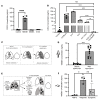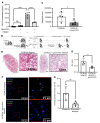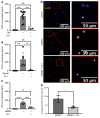CD11b suppresses TLR activation of nonclassical monocytes to reduce primary graft dysfunction after lung transplantation
- PMID: 35838047
- PMCID: PMC9282933
- DOI: 10.1172/JCI157262
CD11b suppresses TLR activation of nonclassical monocytes to reduce primary graft dysfunction after lung transplantation
Abstract
Primary graft dysfunction (PGD) is the leading cause of postoperative mortality in lung transplant recipients and the most important risk factor for development of chronic lung allograft dysfunction. The mechanistic basis for the variability in the incidence and severity of PGD between lung transplant recipients is not known. Using a murine orthotopic vascularized lung transplant model, we found that redundant activation of Toll-like receptors 2 and 4 (TLR2 and -4) on nonclassical monocytes activates MyD88, inducing the release of the neutrophil attractant chemokine CXCL2. Deletion of Itgam (encodes CD11b) in nonclassical monocytes enhanced their production of CXCL2 and worsened PGD, while a CD11b agonist, leukadherin-1, administered only to the donor lung prior to lung transplantation, abrogated CXCL2 production and PGD. The damage-associated molecular pattern molecule HMGB1 was increased in peripheral blood samples from patients undergoing lung transplantation after reperfusion and induced CXCL2 production in nonclassical monocytes via TLR4/MyD88. An inhibitor of HMGB1 administered to the donor and recipient prior to lung transplantation attenuated PGD. Our findings suggest that CD11b acts as a molecular brake to prevent neutrophil recruitment by nonclassical monocytes following lung transplantation, revealing an attractive therapeutic target in the donor lung to prevent PGD in lung transplant recipients.
Keywords: Immunology; Integrins; Monocytes; Transplantation.
Conflict of interest statement
Figures








Similar articles
-
Update on the immunological mechanisms of primary graft dysfunction and chronic lung allograft dysfunction.Curr Opin Organ Transplant. 2024 Dec 1;29(6):412-419. doi: 10.1097/MOT.0000000000001175. Epub 2024 Oct 16. Curr Opin Organ Transplant. 2024. PMID: 39422603 Review.
-
Donor pulmonary intravascular nonclassical monocytes recruit recipient neutrophils and mediate primary lung allograft dysfunction.Sci Transl Med. 2017 Jun 14;9(394):eaal4508. doi: 10.1126/scitranslmed.aal4508. Sci Transl Med. 2017. PMID: 28615357 Free PMC article.
-
Residual endotoxin induces primary graft dysfunction through ischemia/reperfusion-primed alveolar macrophages.J Clin Invest. 2020 Aug 3;130(8):4456-4469. doi: 10.1172/JCI135838. J Clin Invest. 2020. PMID: 32692317 Free PMC article.
-
IL-1β-dependent extravasation of preexisting lung-restricted autoantibodies during lung transplantation activates complement and mediates primary graft dysfunction.J Clin Invest. 2022 Oct 17;132(20):e157975. doi: 10.1172/JCI157975. J Clin Invest. 2022. PMID: 36250462 Free PMC article.
-
Role of innate immunity in primary graft dysfunction after lung transplantation.Curr Opin Organ Transplant. 2013 Oct;18(5):518-23. doi: 10.1097/MOT.0b013e3283651994. Curr Opin Organ Transplant. 2013. PMID: 23995372 Review.
Cited by
-
Toll-like receptors and integrins crosstalk.Front Immunol. 2024 Jun 10;15:1403764. doi: 10.3389/fimmu.2024.1403764. eCollection 2024. Front Immunol. 2024. PMID: 38915411 Free PMC article. Review.
-
ECRG4 mediates host response to cutaneous infection by regulating neutrophil recruitment and adhesion receptor expression.PLoS One. 2024 Nov 7;19(11):e0310810. doi: 10.1371/journal.pone.0310810. eCollection 2024. PLoS One. 2024. PMID: 39509414 Free PMC article.
-
Targeting Macrophages in Organ Transplantation: A Step Toward Personalized Medicine.Transplantation. 2024 Oct 1;108(10):2045-2056. doi: 10.1097/TP.0000000000004978. Epub 2024 Mar 12. Transplantation. 2024. PMID: 38467591 Review.
-
Advances in lung ischemia/reperfusion injury: unraveling the role of innate immunity.Inflamm Res. 2024 Mar;73(3):393-405. doi: 10.1007/s00011-023-01844-7. Epub 2024 Jan 24. Inflamm Res. 2024. PMID: 38265687 Review.
-
Primary Graft Dysfunction in Lung Transplantation: An Overview of the Molecular Mechanisms.Int J Mol Sci. 2025 Jul 15;26(14):6776. doi: 10.3390/ijms26146776. Int J Mol Sci. 2025. PMID: 40725023 Free PMC article. Review.
References
Publication types
MeSH terms
Substances
Grants and funding
LinkOut - more resources
Full Text Sources
Medical
Molecular Biology Databases
Research Materials
Miscellaneous

